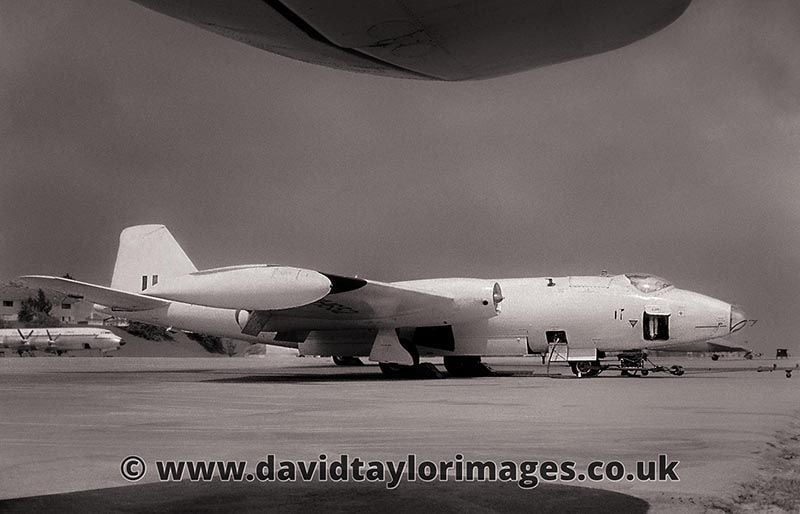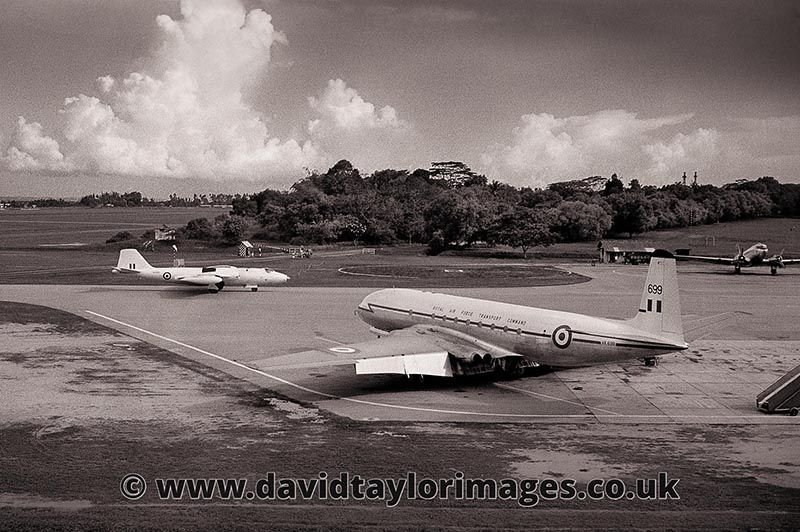Ferrying Canberra U10's to Woomera
Thread Starter
Join Date: Dec 2008
Location: Near Bridport, Dorset UK
Age: 76
Posts: 97
Likes: 0
Received 0 Likes
on
0 Posts
Ferrying Canberra U10's to Woomera
In 1961 and 1962 I saw a number of Canberra U10 drones being ferried through RAF Changi in Singapore, on their way to Edinburgh Field to become 'sacrifices' in the development of the Bloodnound and Thunderbird ground-to-air missiles. I have discovered that "They could be flown with a pilot aboard who flew it via a supervisory panel installed in the cockpit that, by the use of 13 push buttons, simulated the inputs transmitted to the aircraft when flown unmanned. When flown without a pilot the U.10 was controlled via a VHF link from a control van. The aircraft had an explosive abort device on board in case of emergencies such as loss of contact" ('ADF Serials' web page). One such pilot was Australian John Parker: "In 1960, John had a very interesting posting to Woomera, SA, as a member of No. 1 Air Trials Unit Target Aircraft Flight. This unit operated the pilotless V12 Jindivik, Meteor U15 and Canberra U10 aircraft as targets for radar tracking and live firing, using surface-to-air (SAM) and air-to-air (AAM) weapons. He was a member of the team which flew the aircraft unmanned, but also the test pilot who conducted the flight tests sitting in aircraft under remote control from take-off to landing on the flight before an unmanned live firing at the target aircraft. This flight could be a rather nerve-racking experience, particularly the landing" (airforce.gov.au web site).
It must have been an experience to 'fly by 13 push buttons, simulating the inputs transmitted when flown unmanned'...unless of course they were also able to be flown by the usual controls during the long ferry flights. Does anyone know how this undertaken?

Canberra U10 WH652 at Changi on 15th March 1962.
Many more 1960's Singapore images at david taylor images | AVIATION
David Taylor
It must have been an experience to 'fly by 13 push buttons, simulating the inputs transmitted when flown unmanned'...unless of course they were also able to be flown by the usual controls during the long ferry flights. Does anyone know how this undertaken?

Canberra U10 WH652 at Changi on 15th March 1962.
Many more 1960's Singapore images at david taylor images | AVIATION
David Taylor
Dave,
Indeed, you are correct (as far as I am aware!) . All drones that I had dealings with retained conventional controls. That is not to say that there were others of which I was unaware!
Bill
Indeed, you are correct (as far as I am aware!) . All drones that I had dealings with retained conventional controls. That is not to say that there were others of which I was unaware!
Bill
Thread Starter
Join Date: Dec 2008
Location: Near Bridport, Dorset UK
Age: 76
Posts: 97
Likes: 0
Received 0 Likes
on
0 Posts
Transistor technology was still in it's infancy in 1961/62 and the Canberra U10 would certainly have still been using valves in the radio link equipment for them to be controlled from a ground station. That would have meant large equipment taking up valuable space in a Canberra or Meteor.
The Canberra U10's I photographed, arriving in Singapore singly on their ferry flights, would have required a crew of pilot and navigator so it would have been interesting to have looked inside and see how much of their already limited space was taken up with the electronics.
The Canberra in the photo at the top of the page, WH652 an ex-B2 model. In 1953 this aircraft had been involved in 600 hour ‘intensive flying trials’ of the Avon engines. The 600th hour was completed in 50 days, in which time some 300,000 miles were flown. Turn-round time to get the Canberra airborne again improved tremendously as the trial progressed; the average for the first month was 1 hr 35 min, for the second month 1 hr 10 min and for the third month 36 min.
Seems sad that this aircraft, still a 'front line type' in Germany, the Middle and Far East, was destroyed at Woomera by a missile on 12th February 1964; this aircraft needed ‘TLC’ - not blowing up!
Here's a picture of another arriving, taxying into the Western Dispersal at Changi on the 7th June 1962, a Canberra U-10 WH885 on it’s delivery flight to Edinburgh Field to take part in those trials. The remote controls were obviously not without problems and WH885 was destroyed on April 1st 1964 at Woomera, when control was lost whilst being remotely piloted from the ground. The “self destruct” switch was activated, and the aircraft was blown up in flight.
In front is 216 Squadron Comet C2 XK699, parked in this instance with flaps fully down, obviously u/s.

More from Singapore in the '60s at david taylor images | AVIATION
David
The Canberra U10's I photographed, arriving in Singapore singly on their ferry flights, would have required a crew of pilot and navigator so it would have been interesting to have looked inside and see how much of their already limited space was taken up with the electronics.
The Canberra in the photo at the top of the page, WH652 an ex-B2 model. In 1953 this aircraft had been involved in 600 hour ‘intensive flying trials’ of the Avon engines. The 600th hour was completed in 50 days, in which time some 300,000 miles were flown. Turn-round time to get the Canberra airborne again improved tremendously as the trial progressed; the average for the first month was 1 hr 35 min, for the second month 1 hr 10 min and for the third month 36 min.
Seems sad that this aircraft, still a 'front line type' in Germany, the Middle and Far East, was destroyed at Woomera by a missile on 12th February 1964; this aircraft needed ‘TLC’ - not blowing up!
Here's a picture of another arriving, taxying into the Western Dispersal at Changi on the 7th June 1962, a Canberra U-10 WH885 on it’s delivery flight to Edinburgh Field to take part in those trials. The remote controls were obviously not without problems and WH885 was destroyed on April 1st 1964 at Woomera, when control was lost whilst being remotely piloted from the ground. The “self destruct” switch was activated, and the aircraft was blown up in flight.
In front is 216 Squadron Comet C2 XK699, parked in this instance with flaps fully down, obviously u/s.

More from Singapore in the '60s at david taylor images | AVIATION
David
Join Date: May 2017
Location: Bournemouth
Posts: 44
Likes: 0
Received 0 Likes
on
0 Posts
On the Sea Vixen D3 program, completely normal controls were retained and the pilot could also fly by push buttons that mimicked the ground based radio commands.
In the event of some sort of emergency and the electronic hydraulic servo valves for the remote control became locked somehow, there were electrically fired explosive bolts for the control surfaces that severed the drone specific mechanical control links. This was activated off the stick by using the redundant "fire" button from one of the weapon systems that were of course no longer active.
In the event of some sort of emergency and the electronic hydraulic servo valves for the remote control became locked somehow, there were electrically fired explosive bolts for the control surfaces that severed the drone specific mechanical control links. This was activated off the stick by using the redundant "fire" button from one of the weapon systems that were of course no longer active.
The U.10 was designed so it could be flown either manually (for ferry flights), by the autopilot via the pilot's supervisory control panel (for autopilot check flights), or by the autopilot via ground radio control (as an unmanned target). The aircraft had a single navigator's position in rear cabin for ferry flights, the right hand side of which was occupied by elements of the autopilot system (gyros etc). The radio control system was accommodated in a large crate slung in the bomb bay. Autopilot control was via electrically-driven servomotors.
On the Sea Vixen D3 program, completely normal controls were retained and the pilot could also fly by push buttons that mimicked the ground based radio commands.
In the event of some sort of emergency and the electronic hydraulic servo valves for the remote control became locked somehow, there were electrically fired explosive bolts for the control surfaces that severed the drone specific mechanical control links. This was activated off the stick by using the redundant "fire" button from one of the weapon systems that were of course no longer active.
In the event of some sort of emergency and the electronic hydraulic servo valves for the remote control became locked somehow, there were electrically fired explosive bolts for the control surfaces that severed the drone specific mechanical control links. This was activated off the stick by using the redundant "fire" button from one of the weapon systems that were of course no longer active.
On one occasion, I remember an FR test pilot arriving, leaping into a Vixen and knocking himself out on the canopy!!
Join Date: May 2017
Location: Bournemouth
Posts: 44
Likes: 0
Received 0 Likes
on
0 Posts





